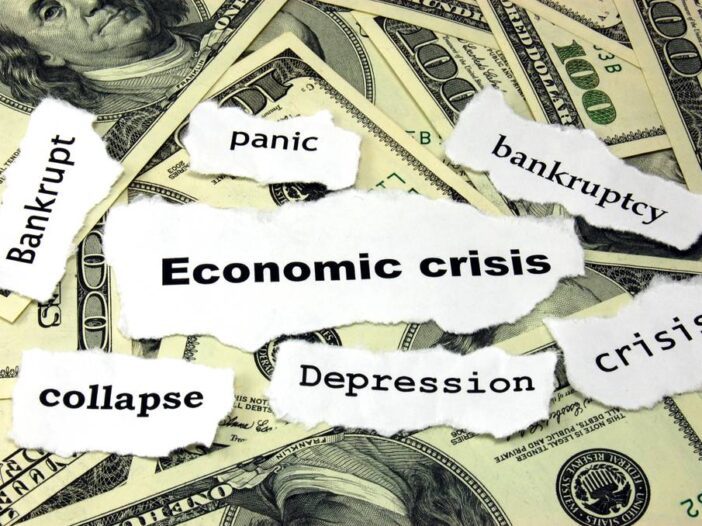I once held the commonly accepted view that an economic collapse causes asset prices to collapse to oblivion.
Houses, stocks, commodities…everything.
We saw it happen in history — The Great Depression, Black Monday 1987, the Nikkei Bubble in the 1990s, the 2007–09 Subprime Crisis…the list goes on.
I think people are primed to believe that the price will collapse when a market crashes. It is in the history books. They also experienced it firsthand just over 10 years ago.
Now, you may think that I am nuts to suggest that an economic collapse will cause anything but a price collapse.
But bear with me on this. The logic is very simple to see why it might be different next time…
Pricing assets in fiat currency
Recall that all asset prices are denominated in fiat currency. You can say the price is how many units of the dollar buys a particular good, service, or asset.
Price is just measuring the relative value of two things. We just make it easier to trade by expressing everything in Aussie dollar terms.
You have noticed over time that your income has been rising and so has the cost of living.
But your standard of living does not improve unless you earn more than you spend. The average Australian worker is not earning more in real terms. I use gold and property as proxies.
So what is going on?
The key is that the dollar is getting more worthless compared to most of the things we need in our daily lives.
What is the cause? Our debt time bomb.
How to Survive Australia’s Biggest Recession in 90 Years. Download your free report and learn more.
Australia’s debt problem
Australia has a debt clock. You can find it here.
The total debt that the Australian government (federal, state, and local), private sector, and households hold amounts to almost $8 trillion.
Private credit or business loans add up to almost $5 trillion, followed by household debt being almost $3 trillion, and government debt is over $1.3 trillion. The reason why they do not add up to $8 trillion is because banks and financial institutions lend to each other, and hence there is double counting.
To put a perspective on how much debt has grown, the website says the total credit in Australia increased 620% from 1989 to 2016, when it stood at $6.3 trillion. It has increased another 27% since then.
Debt has grown on average at 7.6% pa over this period. Put simply, it doubles every nine years.
The fractional reserve lending system from banks can perpetuate the debt cycle because you can lend more than $1 for every $1 capital that the bank has.
They can charge interest on the loan and then use that to justify being able to create more cash to lend. In other words, they can create this almost ad nauseum.
Credit crunches: Look here, don’t look here
You have seen in recent times how the financial experts and media pundits wring their hands in woe worrying about the risk of another credit crunch.
A credit crunch occurs when economic activity grinds to a halt when borrowers cannot repay their loans and the lenders are too scared to lend to each other. This causes business activity to slow down and asset markets to crash.
This is why economists and central bankers keep saying they are worried about deflation. They want us to be afraid of a market crash, sending prices falling.
But you have seen how the central banks ‘rescued’ the market last time in 2007–09. They pumped billions upon billions worldwide to reflate the market.
The feel-good factor of rising prices made people think that they have averted the disaster.
The truth behind a credit crunch is that the central bankers reset their fiat currency system to perpetuate it.
Market crashes leading to lower prices means their fiat currency is more valuable again. They can buy up our time and freedom for less.
My view is do not fall for this trick. They have another plan coming.
Hyperinflation ahead!
Those running the current central banking system know that their system is due for a reboot. They did it before in 1971.
They have become more brazen this time with the World Economic Forum’s Founder Klaus Schwab talking about ‘The Great Reset’.
The global virus outbreak, lockdowns, and crunching the global supply chain are meant to cause a monumental market crash. The Open Society’s George Soros, a notorious globalist, had foreshadowed that asset prices could collapse.
However, I sense that they are talking doublespeak. They want to hedge it both ways. If they can cause prices to collapse, mission accomplished. If they cannot, then hyperinflate it by drowning the world in debt and then use it to seize people’s assets if they cannot repay.
I lean on them using the latter. They have saddled governments, businesses, and households with debt. Governments are handing out packages to businesses and households wracked by the lockdowns. All lending institutions have to do is to recall these loans at the right time and take possession of assets.
The plan sounds meticulous, but I think it will fail.
The failure is in the hyperinflation. Somewhere, the people worldwide will band together and make the central banks pay for their chicanery. They will turn the fiat currency into worthless junk and default on their debt. It will be a financial struggle of epic proportions.
You have seen cryptocurrencies, gold, commodities, and real estate rise up parabolically. The people have realised and started to act. I think we will see more of this in the future.
Position yourself for the crash…up, up, and away!
Regards,
 |
Brian Chu,
Editor, The Daily Reckoning Australia
PS: Our publication The Daily Reckoning is a fantastic place to start your investment journey. We talk about the big trends driving the most innovative stocks on the ASX. Learn all about it here.

